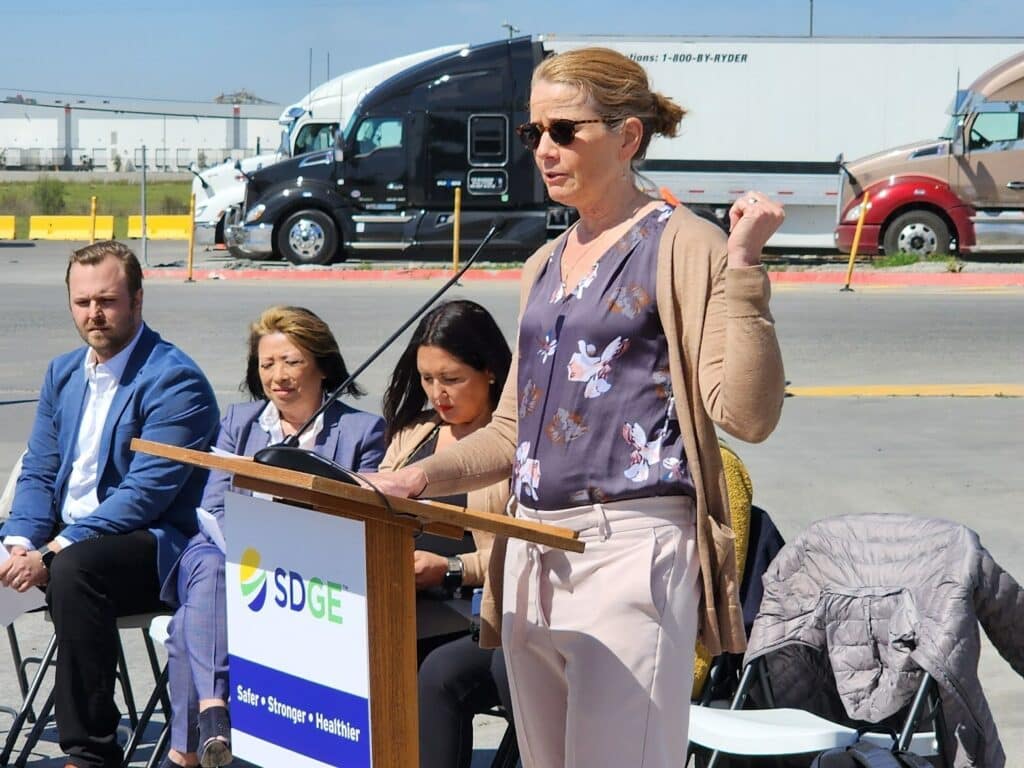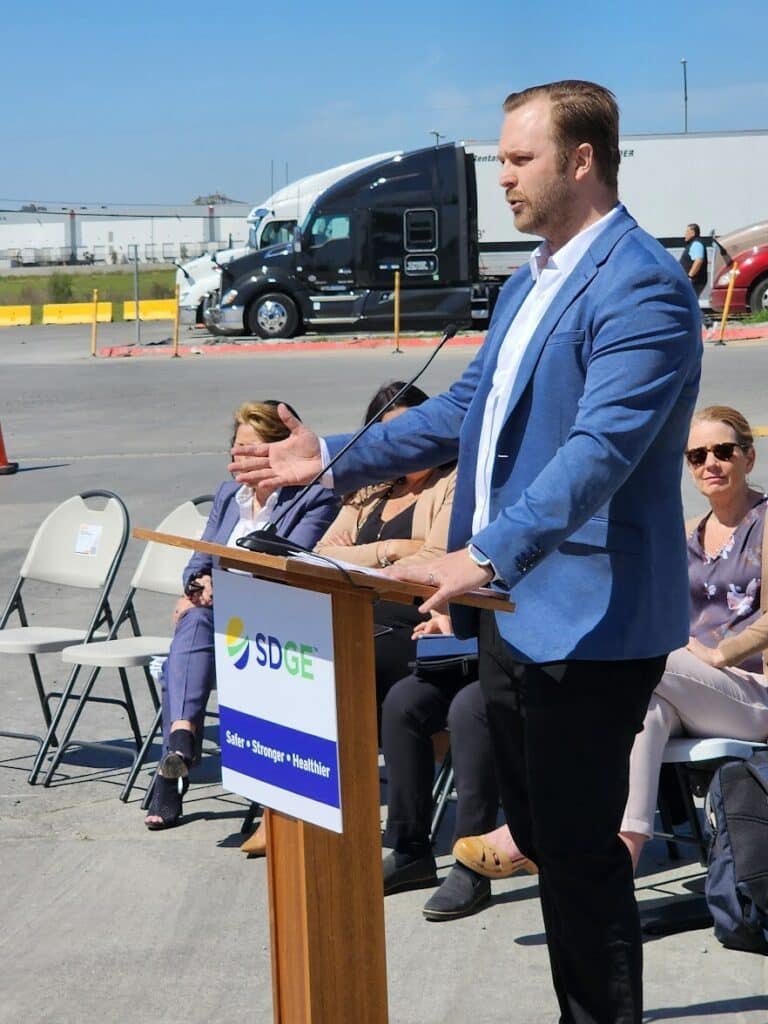CA’s First Public, DC Fast Chargers for Medium and Heavy-Duty Electric Vehicles at a Truck Stop Open for Public Use
Today marks a significant milestone in California’s journey towards a clean energy future, as San Diego Gas & Electric, in partnership with local and state officials, launched four public direct current (DC) fast chargers. Strategically located at a bustling truck stop just north of the Otay Mesa Port of Entry, these chargers are the first of their kind to be unveiled at a truck stop in the state. While primarily aimed at providing high power charging for medium and heavy-duty vehicles like trucks, delivery vans, and buses, these state-of-the-art chargers are versatile enough to serve passenger cars as well. This initiative is a significant step towards reducing carbon emissions and promoting a sustainable transport environment.

Located at the Truck Net LLC, 8490 Avenida de la Fuente, close to the U.S./Mexico border, are new 250-kilowatt (kW) chargers. They have the capability to provide up to 250 miles per hour of charging for a passenger car, making them a game-changer in the electric vehicle charging industry. Not only can they swiftly charge passenger cars, but they also have the capacity to charge a typical medium-duty box truck from 20% to 80% in approximately an hour. If starting from an empty battery, a full charge can be achieved in around two hours, which is a testament to their efficiency and power.
The Otay Mesa Port of Entry is the busiest commercial border crossing in California, allowing nearly one million commercial trucks and five million privately owned vehicles to cross yearly. Idling vehicles waiting at the border crossing is a key contributor to air pollution in the San Diego region.
“Reducing air pollution and tailpipe emissions are top priorities for our region and California especially in equity priority communities, and SDG&E is committed to building the infrastructure needed to enable businesses and residents to adopt electric vehicles and other clean technologies,” said SDG&E CEO Caroline Winn. “We all share the goal of building a cleaner, more sustainable and healthier future.”
Representing a spectrum of influential leadership, several dignitaries graced the event alongside Winn. Among these were Patty Monahan, the esteemed California Energy Commissioner (CEC) known for her championing of sustainable energy solutions. San Diego County Board of Supervisors Chair Nora Vargas also attended, an influential figure who wears many hats in service to her community. She currently serves on the California Air Resources Board and the County Air Pollution Control District board. In addition, she holds the position of chair at the San Diego Association of Governments (SANDAG) board, further amplifying her impact in the region.
“Air pollution doesn’t recognize national boundaries, and to accommodate the transition to zero-emission trucks on both sides of the border, it’s critically important that we rapidly scale up the charging network,” said Commissioner Monahan. “The California Energy Commission is helping fund this project and others across the state to build a better and more equitable charging infrastructure system for both cars and trucks.”

The chargers are funded by a generous $200,000 grant through the CEC’s Clean Transportation Program. Now in its impressive 14th year, the program has played an instrumental role in establishing California as a forerunner in zero-emission transportation. It has provided over $1 billion to alternative fuel and vehicle technology projects, delivering significant health, environmental, and economic benefits to numerous communities. However, it is important to note that funding for the program is scheduled to phase out at the end of the year.
SDG&E built the underlying infrastructure tying the chargers to the grid, as part of its Power Your Drive for Fleets program. This program serves as a vital link, connecting fleet operators to an array of resources and financial incentives. These benefits make it both feasible and economically viable for operators to design and install charging infrastructure tailored specifically for medium and heavy-duty fleets. The initiative not only consolidates SDG&E’s commitment to sustainable transportation but also fosters a conducive environment for the further development of zero-emission transportation.
Chair Vargas, the representative of Otay Mesa and a prominent advocate for environmental justice and equity, underscored the necessity of minimizing emissions in border communities and communities of color. These communities have suffered disproportionately from pollution due to their closeness to high traffic corridors, enduring health and environmental consequences that have gone unchecked for far too long. She believes that the deployment of these clean energy transportation options is a significant step towards rectifying these issues, contributing to a healthier, more equitable future.
“As a fronteriza and someone who has experienced first-hand the air pollution associated with long lines of idling vehicles waiting to cross the border, I am thrilled to see the electric vehicle chargers installed at this truck stop,” said Supervisor Nora Vargas, chair of the San Diego County Board of Supervisors. “This is a true community infrastructure solution that proves that through public-private partnerships, we can improve poor air quality for families and children and promote economic prosperity for the binational region.”
This project aligns directly with Governor Gavin Newsom’s executive order stipulating that all new passenger vehicle sales must be zero-emission by 2035, and medium and heavy-duty vehicles (class2b-8) to be zero-emission where feasible by 2045. According to the California Energy Commission (CEC), nearly a million battery-electric vehicles have already been sold in California, and approximately 2,000 zero-emission trucks and buses are currently in operation. The state boasts over 80,000 public and shared private EV chargers. The lion’s share, around 90%, are Level 2 chargers, offering 14-35 miles of range per hour of charging, while the remaining 10% are DC fast chargers. The commitment to developing zero-emission transportation infrastructure is evident and unyielding, reflecting California’s steadfast dedication to curbing climate change.
SDG&E is an innovative San Diego-based energy company that provides clean, safe and reliable energy to better the lives of the people it serves in San Diego and southern Orange counties. The company is committed to creating a sustainable future by providing its electricity from renewable sources; modernizing natural gas pipelines; accelerating the adoption of electric vehicles; supporting numerous non-profit partners; and, investing in innovative technologies to ensure the reliable operation of the region’s infrastructure for generations to come. SDG&E is a subsidiary of Sempra (NYSE: SRE). For more information, visit SDGEnews.com or connect with SDG&E on Twitter (@SDGE), Instagram (@SDGE) and Facebook.


